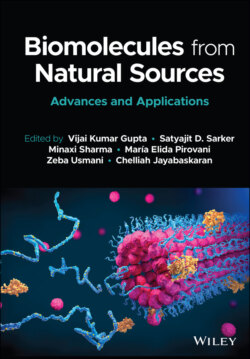Читать книгу Biomolecules from Natural Sources - Группа авторов - Страница 84
2.8 Biopolymer Type Number 7: Polyphenols
ОглавлениеPhenolic compounds are defined chemically by the presence of at least one aromatic ring bearing one (phenols) or more (polyphenols) hydroxyl substituents, including their functional derivatives (such as esters and glycosides). Polyphenols can be roughly divided into LMW compounds and HMW Lignins [268]. Humic acids are important substances because they constitute the most ubiquitous source of non-living organic material that nature knows. Humic acids have important roles in soil fertility and stability. Humic acids also have industrial applications in the development of absorbents to be used at the source of metal-poisoning. Such properties extend their application to the fields of agriculture and medicine [269]. Tannin is another example of plyphenols. Polyphenols can be defined as secondary metabolites of relatively high molecular weight and diverse structural complexity that are synthesized by plants exclusively from the shikimate-derived phenylpropanoid and/or the polyketide pathway(s) in response to different types of stress (hydric or saline) or aggressive factors (bacteria, fungi, virus, ultraviolet radiation, etc.) [270–272]. Polyphenols are generally classified based on their chemical structures [273]. Four major classes of polyphenols are known and they are found in phenolic acids, flavonoids, lignans, and stilbenes. Phenolic acids are divided into hydroxybenzoic and hydroxycinnamic acids. The hydroxycinnamic acids are more common than hydroxybenzoic acids, and they include gallic acid, p-coumaric acid, caffeic and chlorogenic acids, and also ferulic and sinapic acids. These acids are rarely found in free form and are usually extracted as glycosylated derivatives or esters of quinic acid, shikimic acid and tartaric acid. Flavonoids are the most numerous of the phenolic compounds in plant products and are divided in several subclasses: flavonols, flavones, flavan-3-ols, flavanones, anthocyanidins and isoflavones, and other minor components of the diet such as coumarins or chalcones. Polyphenols are widely distributed in the higher plant kingdom; they are present in fruits, vegetables, herbs, spices, tea, and wine [274–276]. They show a great diversity of structures, ranging from rather simple molecules to polymers [277], with or without glycosylation and/or esterification. They may be classified in different groups as a function of the number of phenol rings that they contain and the structural elements that bind one ring to another [278]. Polyphenols have the ability to form a complex strongly with metal ions and macromolecules such as polysaccharides and proteins (Haslam 1998); hence, they present biological activities that make them attractive for nutraceutical and medicinal applications [279–283]. Particularly, polyphenols play a key role in the inhibition of enzymes related to cardiovascular and neurodegenerative diseases, as well as cancer and diabetes [272]. There is evidence that they prevent oxidation of LDL-lipoprotein [284–286], platelet aggregation [287, 288], and oxidative cell damage [289, 290]. Additionally, polyphenols act as antimutagens, anticarcinogens [291, 292], and antimicrobial agents [292–294]. Despite their demonstrated bioactive properties, the action of polyphenols on biological systems is complex and disputed because it is affected by bioavailability, doses, metabolism, and other biotransformations. Bioavailability is strictly related to their structures, like degree of glycosylation and conjugation with other polyphenols. For example, polymers such as proanthocyanidins may have direct effects on the stomach [292] and intestinal mucosa, protecting these tissues from oxidative stress or carcinogen action [277]. In addition, non-glycosylated phenolic compounds may be absorbed directly into the small intestine [277]. In turn, to become absorbed in the intestine, polyphenols present in the form of esters, glycosides, or polymers require hydrolyzation by enterocyte enzymes or through the action of colonic microbiote [295]. The antioxidant activity of polyphenols is arguable. On the one hand, studies in cell line cultures have shown that polyphenols are able to reduce oxidative stress and activate the antioxidant response of the cells. On the other hand, they could decrease cell viability and proliferation and induce cell apoptosis by acting as prooxidants and generating free radicals [296]. The effects of polyphenols in cell cultures (either protective antioxidant or prooxidant/cytotoxic) will depend on several factors such as their concentration, their ability to oxidize, their lipophilicity, the content of other antioxidants and metals, and the oxidative stress level of the cell culture [297–299]. Therefore, to safely use polyphenols as bioactive compounds it is necessary to carefully study aspects such as the specific dose, the delivery vehicle, the nutritional and health history, and the characteristics of the microbe.
